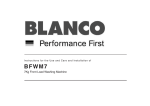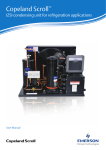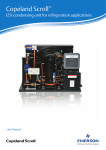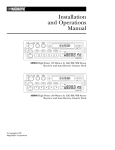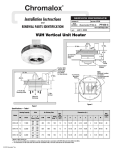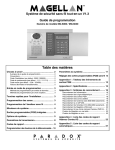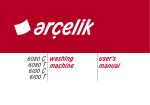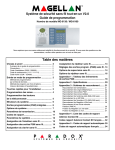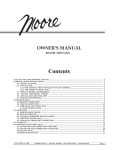Download Beko D 7081E Washer User Manual
Transcript
Dear Customer,
We wish that this product, manufactured at modern facilities with total quality
notions, will deliver you the best performance. In order to guarantee this, please
read this instruction manual thoroughly and keep it for your future reference.
Contents
1
Technical features
Page 3
2
Steps before operating Fullautomatic
Washing Machine and safety precautions
Page 6
3
Preparation
Page 8
4
Program selection and washing operations
Page 13
5
Care and Maintanence
Page 19
6
Determining location and installation
Page 21
7
Helpful tips on stain removal
Page 24
8
Before calling service
Page 24
1
Technical features
Models
D 7081 E
D 7082 E
D 7101 E
D 7102 E
D 7102 ES
Maximum capacity (kg.)
7
7
7
7
Height
(cm.)
85
85
85
85
Width
(cm.)
60
60
60
60
Depth
(cm.)
59
59
59
59
Net weight
(kg.)
74
74
74
74
220/50
220/50
220/50
220/50
Power requirement
(V/Hz)
Nominal current
(A)
10
10
10
10
Power
(W)
2100
2100
2100
2100
Washing speed
(rpm)
52
52
52
52
Spin speed
(rpm)
800
800
1000
1000
cold
water
inlet
Hot&cold
water
inlet
cold
water
inlet
Hot&cold
water
inlet
2
The appearance and specifications
are subject to change without notice
to raise the unit quality.
The graphics shown in the manual
are schematic and it is possible that
they not conform with your washing
machine.
Your Washing Machine
Top lid
Control panel
Front door
Kick plate
Kick plate cover
3
2
Steps before operating Fullautomatic Washing Machine and safety precautions
• The current requirement in order for safe operation of this machine is 16 Ampheres. You will need to have a certified
electrician to connect a 16 Amp fuse, if there is not enough current load.
• Your washing machine is set to 230 Volts.
• Do not forget to check the grounding in all cases of use with or without the transformer. Our company will not be
responsible for any damages caused by operations without grounding.
• The performance of the washing machine depends on the effectiveness of the cleaning agent. Stains can be
permanent if low quality detergents are used. Please take necessary effort to clean the stained clothes as described
in following pages before washing them in the machine.
• Your washing machine is designed only for domestic use.
• In order to bring the machine ready to use, please call your service technician or a certified plumber.
• If the power cord or the plug is damaged, please call a certified technician.
• Always use new “water inlet hose” received within your machine.
• Please perform the first wash with detergent, at COTTON 90 program and without placing your laundry inside the
washing machine. This will ensure that the drum is free from any left over dirt from production .
Due to the quality control processes during production, there may be some water left over in your machine.
This does not cause any damage to your product.
4
3
Preparation
Attention! Before any operation of the machine check the following.
• Did you close the front door?
• Is the tap open?
• Is water drain hose placed properly?
• Is power connected?
Sorting laundry
Sort the laundry according to the following groups and wash them seperately:
- white and resistant colored fabrics,
- colored fabrics,
- delicate fabrics (silk, rayon etc.),
- wool.
Be sure to empty pockets and remove any belts, buttons, pins, etc. from the clothing. You can place little clothing materials
(baby socks, etc) inside of pillow cases to avoid them slip into the pump and filter. For stained fabrics, refer to the “Practical
information” section of the operating manual.
Open the front door
To open the front door press the “door open” button.
For your safety, front door can be opened only when the machine is off.
Loading the machine
Place the fabrics uniformly inside the machine. Hand knits should be placed inside out in the machine. Make sure that there
is no clothing at the side of the door. Close the door by pushing lightly. If the door does not close completely, the machine
could not be started-a safety measure. Front door is locked untill the end of the washing program and it will not be opened
about 2 minutes following the end of the program.
5
Detergent and softener selection
Choose the appropirate detergent specifically used at the full automatic washing machines. Suggested amount is given
on the detergent cover.
Do not attempt to use detergents and bleaching elements that contain chlor and sulphur. The amount of the detergent
depends on the dirt level of fabric, the amount of fabric and the softness of the water.
Detergent Dispenser
The detergent dispensing drawer comprises 3 compartments:
– left compartment ( II ) for main wash
– middle compartment for fabric softener
– right compartment ( I ) for pre-wash
WARNING!
When the CURTAIN program is selected Pre-wash function is automatically set. Pre-wash
can be operated even without detergent.
Attention! Fill the softener according to the supplier recommendation (app. <100 ml).
Do not exceed the “MAX level” marked on the detergent dispenser.
6
Control Panel
Auxillary washing machine
Program selection knob
Door open button
On/Off Button
Program follower
Spin speed selection
Remain time
Timedelay adjustment button
Start/Pause/Cancel button
7
Functions
Quick wash
Shortens washing time for lightly soiled fabrics. This function can be used for cotton and synthetic programs for temperatures
below 60° C.
Rinse plus
By using this function your machine will add another rinse process to the three rinse processes that it has already
done. This additional rinse will reduce any affects on sensitive skin by washing leftover detergent.
Anti Creasing
To avoid wrinkling of your clothes, select this function. When Anti-Creasing is choosen please load less cloth, this way a special
washing and spinning profile will reduce the wrinkles and your clothes will be easy to iron.
Spin Speed Selection
Using this button, you can select final spin speed upto 1400/1200 rpm. If you do not want to apply spinning to your clothes,
select “No Spin” option.
Rinse Hold
If you desire to leave your synthetic and wool fabrics in the machine after the wash program you may select the Rinse hold
option to prevent them getting wrinkled. If you want to cancel the “Rinse Hold” function, you have to press on “Start/Pause/Cancel”
button first, select the desired spin speed and then repress on the “Start/Pause/Cancel” button.
8
4
Program Selection and Washing Machine Operation
Insert the plug. Press the On/Off button and then the Door Open button. Open the door. Place your laundry into the machine according
to the recommended load capacity and close the front door.
Select the proper program according to the dirt strength and the thermostat value by means of Program Selection Table given on
the following pages.
Turn the program selection knob and set the desired program. Select the spin speed according to the desired program. Select desired
auxiliary functions.
Then, fill the fabric softener and the detergent into the related compartments, and close the detergent dispenser box. Push the
Start/Pause button to operate your machine. In the mean time the Start/Pause led
will be on. You can follow the washing
steps by means of the program follower.
II
1
2
3
4
5
6
7
8
9
10
11
I
9
Heavy soiled fabrics made from cotton or linen,
Cotton 90 heat resistant
Normal soiled fabrics made from cotton or linen,
Cotton 60* heat resistant
Lightly soiled fabrics made from cotton, non-color
Cotton 40 fast
Heavy soiled fabrics made from cotton or linen,
Intensive 60 heat resistant
Normal soiled fabrics made from cotton/synthetics
Synthetics 60 blended, heat resistant
Lightly Soiled Easy care fabrics made from cotton,
Synthetics 40 synthetics or blended fabrics (non-color fast)
Very Lightly Soiled Easy care fabrics made from
Synthetics Cold cotton, synthetics or blended fabrics (non-color fast)
Curtain 40 Special programme for curtains
Sensitive, easy care fabrics made from cotton,
Delicate 40 synthetics or blended fabrics
Woollen 40 Hand wash marked easy care, blended fabrics
Woollen Cold Hand wash marked wool and easy care, blended
fabrics
Handwash 30 Special programme for Hand wash marked wool
and silk
Mini 30 Lightly Soiled less amount fabric
Rinse Rinsing
Spin Spinning
Drain Draining
Max
Load
(kg)
Program Description
Pre-wash / 3 rinses /3 intermediate
spins / Final Spin
Main wash /3 rinses /3 intermediate
spins / Final Spin
Main wash /3 rinses /3 intermediate
spins / Final Spin
Main wash /4 rinses /4 intermediate
spins / Final Spin
Main wash /3 rinses /3 intermediate
spins / Final Spin
Main wash /3 rinses /3 intermediate
spins / Final Spin
Main wash /3 rinses /3 intermediate
spins / Final Spin
Prewash
Fabric type
Water
Consumption
(l)
Energy
Consumption
(kWh)
Programme
Program
Duration
(~min)
Program selection
Quick Rinse
Wash Plus
Rinse AntiHold Creasing
Detergent
Dispenser
6
136
55
2.30
•
•
•
•
(capacity 2.5kg)
•
I+II
6
130
45
1.02
•
•
•
•
(capacity 2.5kg)
•
II
6
133
45
0.65
•
•
•
•
(capacity 2.5kg)
•
II
6
169
60
1.30
*
•
(capacity 2.5kg)
•
II
3
112
50
0.95
•
•
•
•
(capacity 1.5kg)
•
II
3
110
50
0.55
•
•
•
•
(capacity 1.5kg)
•
II
•
•
•
(capacity 1.5kg)
•
II
*
•
(capacity 2kg)
3
90
50
0.15
•
Pre-wash /Main Wash /no intermediate spins
/ special final spin profile for anti-creasing
Main wash /3 rinses /no intermediate
spins / Final Spin
Main wash /3 rinses /1 intermediate
spin / Final Spin
Main wash /3 rinses /1 intermediate
spin / Final Spin
Main wash /2 rinses /no intermediate
spin / Final Spin
2
125
65
0.50
*
2
66
55
0.35
•
•
1.5
60
50
0.30
•
•
II
1.5
53
50
0.04
•
•
II
1
43
35
0.15
II
Main wash /2 rinses /Final Spin
2.5
30
50
0.17
II
3 rinses /2 intermediate spin / Final
Spin in Cotton profile
6
50
35
0.15
-
Final Spin in Cotton profile
6
15
-
0.08
-
Drain
-
2
-
-
-
*Energy Labeling program acc. to EN 60456:1999 and IEC 60456 Ed.4 2001
Depending on water, textile and ambient conditions the actual values given on or with the machine can deviate from the declared standard values,
as they are tested according to the laboratory conditions
10
*
•
(capacity 1kg)
I+II
II
Child Lock
To prevent the knobs from being played by your children you may activate “child lock” option. Activating the “Child Lock” option
prevents any change from being made to a set program.
To activate child lock, press both on the second and the fourth auxiliary function buttons together for 3 seconds after the
machine starts the washing operation.
After activating the Pre-wash auxiliary function, its led will be blinking.
Only On/Off button will be in operation when the child lock option is selected.
To deactivate child lock, re-press same auxiliary function buttons (second and fourth) for 3 seconds.
In order to open the door at the end of the washing program or to change program selection, child lock must be deactivated
if selected.
On/Off
When you press the On/Off button, your machine is ready to select the desired program. The door open led will be on and
the door is ready to open. When the desired program is selected, related spin speed can be adjusted and the duration of
the program can be observed on the display. To switch the machine off, repress the On/Off button.
Washing can only then be started when the
button is pressed.
Pressing the On/Off button does not mean that the washing operation is started!
To start the washing, press the Start/Pause button!
11
Auxiliary Function Selection
It is not possible to activate all auxiliary functions in all wash programs. If any auxiliary function is selected, its led will be on.
It is restricted to select some auxiliary functions together. For example, if the cotton program is selected, “quick wash” and
“pre-wash” functions can not be selected at the same time. If “Pre-wash” button is selected first and the “Quick wash” function
next, the led of the pre-wash function will be off as it is not active any more.
Program Follower
If the machine is on, a program can be followed by means of the program follower If a washing step is over and the next
step is started, the led of the previous step will continue to light.
It means if the washing operation is finished, all related washing steps on the program follower will be on.
Pre-wash button led will be on, only if this auxiliary function is selected.
Additional Laundry
Press the Start/Pause button. If the water level does not exceed the limitations, in 1 to 2 minutes door open led will come
on. It means the washing machine is ready to add laundry.
If door open led is not lit up after 1-2 minutes, it means the water level inside the machine is too high and it is not allowed to
open the door and add laundry. (Look at Program Cancelling).
If you change your mind as not adding laundry, press Start/Pause button again to let the program continue.
12
End of the Program
If all the wash programs are finished, all the leds on the program follower will be on . “1-2 minutes” for door open is displayed on
remain time display. After1-2 min door open led will light up.
At the end of the washing, all related leds on the control panel will be on. Related duration time of the selected program is displayed
and the machine is ready to start again.
To switch off the machine, press the On/Off button.
Unloading the machine
Machine stops automatically after all the programs are finished. Turn off the tap. In 1-2 min, after the door open led lights up, press
the door open button and open the door. Press the On/Off button to switch off the machine.
Unload the machine and leave the front door open. Check to see if there is any water left in the door hood. If so, remove with a
soft cloth.
13
Time Delay
By using the time delay buttons, starting time of any program can be delayed. Time delay can be set at intervals of 30 min.
On the display, the delayed starting time is added to the duration of the program.
For example, if the program duration is 2 hours and 16 min and you delayed the program for 2 hours, the display will show “4:16”.
After the time delay is set, press Start/Pause button. The washing period will be started after 2 hours
Program Cancelling
If the program has not started yet, you can cancel the selected program by pressing Start/Pause button for 3 seconds. After 3
seconds the led of the Start/Pause button will be off and the led of the selected program will be on, where it is possible to set a
new program
If the program has started and you want to cancel it, press Start/Pause button for 3 seconds. The program will moveto the “spin”
step and related led on the program follower will be on. Machine will start to pump for draining and the door can be opened
after the door open led is on.
14
5
Care and maintanence
Detergent dispensing drawer
Clean when necessary:
1. Open the drawer as far as possible.
2. Push down the depression on the suction cup and pull the drawer
out completely.
3. Clean the drawer under warm running water. Pull off the suction
cup; Clean
suction cup and opening in the drawer with warm running water,
pierce the opening with a needle if necessary. Replace the suction
cap.
4. Wipe off detergent residue from the drawer guides. If present,
remove calc deposits from the water-jet nozzles (inside the drawer).
Water intake filter
At the end of the water intake connection module and water inlet
hose-tap side, there exists filters. These filters prevent any dirt and
objects passing into the machine. It is advisable that these filters
should be cleaned every 30-40 washes. To clean the filter, first turn
the tap off. Then, disconnect the hose and clean the filter with a
thin brush. If the filter is very dirty, you may clean it by pulling out
with pliers. To clean the filter at the tap side of the hose, pull it out
by hand and clean the filter under the tap water.
Hose
To prevent any leakage, have a technician to control the hoses
every two years. If the machine is placed at cold ambient
temperatures, the water remining inside the pump and hoses should
be removed from the filters. Also to prevent freezing, empty the
water intake hoses by disconnecting from taps.
Foreign matter trap
• Clean the foreign matter trap at least once after every 30 wash
cycles!
• Clean foreign object trap, if foreign objects (coins, buttons, baby
socks,
etc.) are blocking the suds pump.
• Drain left-over water before cleaning (see below).
Drum
Do not leave any metal objects (pins, needles, etc.) inside the
drum. These objects may cause rust on the drum surface. Do not
clean the drum with scratching elements.
15
Cleaning the pump filter
Drain off the water completely…
• before cleaning the foreign matter trap;
• before transporting the machine (e.g. when shifting house);
• when there is a power failure ("emergency draining");
• when there is a danger of frost.
At room temperatures below 0 °C the remaining water in the
appliance could freeze, damaging it.
1. Switch appliance off, unplug the power cable, close the water
tap.
Allow hot suds to cool off sufficiently. This poses a risk of scalding.
2. Open the service door by pushing on the button. Take out the
drain pipe
and hold it over a bowl. Pull the seal off the drain hose and allow
the water
to drain out one bowl at a time.
There may be more than 20 litres of water left in the machine when
the drum is bull (e.g. after a power failure)!
3. Turn the foreign object trap 1/2 turn to loosen it (anti-clockwise)
and soak up the remaining water with a cloth. Once no more water
is coming out, turn the foreign object trap until it is completely free
and remove it.
4. Clean foreign object trap and the pump opening. Check if the
pump impeller
(in the pump opening) can be turned freely.
5. Replace the cap on the drain hose and put it away.
6. Replace the foreign object trap and turn it tight (in clockwise
direction).
7. Close the service door. Water inlet strainer
Clean if water flows very slowly, or not at all.
1. Switch off the machine, turn off the water tap.
2. Take the inlet hose off.
3. Pull out the strainer in Aquasafe or the two strainers in Aquasafe+
(depending
on the model) with universal or needle nosed pliers, clean with a
small soft brush and fit back.
16
6
Determining location and installation
1. Removing transport safety bolts at the rear of the machine
The transport safety bolts must be removed before any operation of the machine. Bolt heads, marked “C”.
“C”, should be turned in a anti clockwise direction until the bolt can be partially withdrawn.
Remove transport safety bolts and rubber bushes by pulling outwards. (A up/down action and a small squirt of washing up
liquid should ease removal.)
Plastic plugs, supplied inside the protective bag and designated as “P”, should be placed in the safety bolt holes according
to the direction shown.
Attention!
Please keep the safety bolts for future transportationand reinstate them before transporting your machine. Never
transport your machine without the transport bolts in position.
Never place your machine on a carpet. This prevents air circulation. The electrical components of the machine
may overheat and may cause damage.
17
2. Feet adjustment
In order for quiet and stable operation, the machine should be placed properly and leveled on its feet.
Your machine comes with two adjustable feet. If the machine is unstable, loosen the plastic counternut
and screw or unscrew the adjustable foot until the machine is leveled perfectly. After positioning,
tighten the counternut for stability.
3. Water connections
a) Water inlet hose
Cold water supply
For proper operation, the pressure of water should be between 1 and 10 atm. (1 atm corresponds to
more than 8 liters per minute flow rate at fully open tap.)
To prevent water leaks sealing washers are supplied with the water inlet hose inside the machine,
place these on each of the hose ends and tighten both ends fully.
In order to prevent any water leak damages, keep the water taps closed when not in use. Connect the
cornered end of the hose to the machine water inlet.
Connect the cold water using the hose with blue printing.
18
b) Water drain hose
4. Electrical connection
Water drain hose could be placed either at the side of the bath tub, or
directly to the drain. The hose should not be bent. Water drain hose should
be secured with the elbow so that it would not fall down on the ground.
Connect the power cord to the appropirate electrical
system which is being supported by the maximum
voltage and current rating indicated on the rating
plate placed inside the kick plate.
Look! Page 1, Steps before operating Fullautomatic
Washing Machine and safety precautions.
The hose should be placed between 40 and
100 cm. from the ground.
Make sure that you have
grounded power outlet.
Water drain hose could be
placed directly to the drain
water inlet.
19
7
Helpful tips on stain removal
The following stain removing tips are approximate and can only be used at the washable fabrics. Please
consult the washing information of the fabric manufacturer.
Alcoholic baverages: Wipe the fabric first with water, then
Blood stain: Leave the fabric for30 minutes in the cold water. Use
water-glycerine solution and rinse with vinegar-water solution.
ammonia solution to remove the stain. (4 liters water3 spoonful of ammonia.)
Shoe polish: Without harming the fabric, remove the stain
Ice-cream, milk and cream: Place the fabric into cold water for
carefully and grind it with detergent. If this doesn’t help, prepare
a water to alcohol solution (2 to 1) and rub the fabric, then
wash it with warm water.
a period of time. Rub it with soap or detergent and wash it with the
warmest water that the fabric can withold. If any grease stain
leftover wipe it with oxygen water.
Tea and coffee: Pour hot water on to the stain and the fabric
is white, pour some bleach and rinse it with water.
BUBBLEGUM
MILDEW
Bubblegum: Harden the gum stain by putting an ice on it.
Then scrape off the stain carefully.
Mildew: Do not let mildew stains stay for long periods of time.
Place the fabric into cold water for a period of time. Rub it with
soap or detergent and wash it with the warmest water that the
fabric can withold. If any grease stain leftover wipe it with oxygen
water.
Fruit: Pour cold water on to the stain and do not use warm water
Chocolate and cocoa: Place the fabric into cold water for a
to rinse. Let it sit for 2 hours and wipe it with white vinegar and
rinse.
period of time. Rub it with soap or detergent and wash it with
the warmest water that the fabric can withold. If any grease
stain leftover wipe it with oxygen water.
Ink: Let the cold water run on the stain and wait until the stain is
Tomato paste: Scrape the hardened paste and leave the
gone. Later rub it with lemon juice and detergent, let the stain stay
for five minutes and rinse the fabric.
Egg stain: If the stain is hardened scrape the stain and wipe
Grass stain: Rub the stain with detergent. If the fabric lets, use
it with wet sponge or a soft cloth. Rub it with detergent and
wash with cold water.
bleachinng element. Wools should be wiped with alcohol.
Grease stain: Scrape the stain and rub it with detergent. Then
Paint: Use thinner to remove the stain. Put a cotton cloth on the
fabric for 40 minutes into cold water. Rub it with detergent and
wash.
wash the fabric with warm water.
MUSTARD
Ratios are
approximated.
wool fabrics. Rub the stain with detergent and rinse with cold water.
Mustard: Use glycerin and rub the fabric with detergent. If
Burnt stains: Use bleach if permissable. For wool fabrics place a
unsuccesful, wipe the stain with alcohol. (Colored and synthetic
fabrics need 2 cups water and 1 cup alcohol solution.)
oxygen water inserted cotton cloth on the stain and iron.
Rinse completely and wash the fabric.
20
8
Before calling service
Water coming from beneath the machine.
You turned the machine on, but the leds are off on
the panel.
Check the grounding on the power cable or a blown fuse.
Check the front door proper closure.
Check the water intake and drain hoses. Tighten the
connections. The washers of the hoses may be worn out. If
non of the both, the pump filter is not closed properly.
Machine does not take water.
Foam coming out of the detergent dispenser.
Check whether your detergent is suitable for automatic
machines. Next time use less detergent.
Check the front door for proper closure. Either taps are
closed or water intake filters are clogged.
Pump does not drain water.
Taken water is directly discharged.
Clean the pump filter. Check whether the drain hose is bent
or not. If there is need to clean the pump filter, refer to the
pump filter cleaning section of the manual.
Check if the discharge hose placed as described in the
users manual or not.
Descriptions of the international textile care label (ITCL) symbols
P
60°
Washing
temperature
No dry cleaning
Bleach can
be used
No spin
Do not use
bleach
Can be washed
at centrifugal
machine
Do not machine
wash
Do not wash
centrifugal
machine
Dry on horizantal
surface
Line dry
21
A
Do not wash
Dry clean
Chemicals can
be used
Iron permitted
Do not iron
Warm iron


























